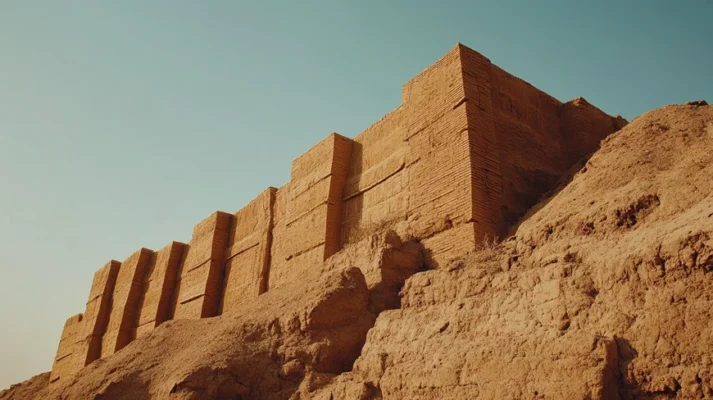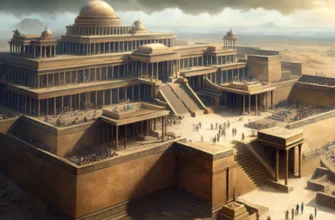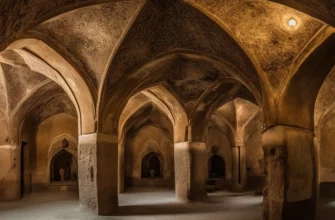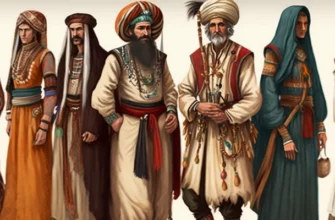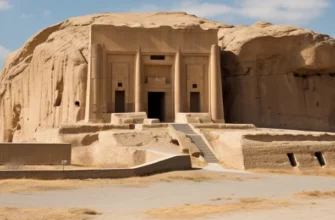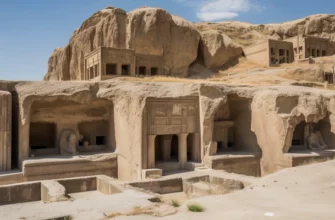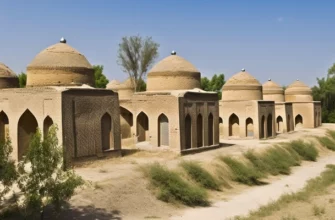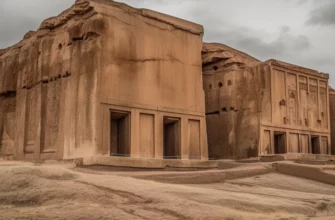Choga Zanbil is one of Iran’s largest and most important archaeological discoveries, preserving numerous traces of ancient civilization. Located in southwestern Iran, this city was founded in 1250 BC by the Hellenistic king Ushshaz, who built it as his religious center.
The main architectural feature of Chogha Zanbil is a temple complex dedicated to the god Zoroaster, who was central to the Zoroastrian religion. It is also known for its huge pyramidal structure, a Zoroastrian temple, which has become a symbol of ancient religious practices.
Choga Zanbil is a testament to the high level of development of ancient Iranian culture and religion, and thanks to its architectural significance, it has been included in the UNESCO World Heritage List.
Today, this place attracts tourists and researchers from all over the world and is important for understanding the history of Iran and the development of ancient civilizations.
Choga Zanbil is an ancient city and archaeological complex located in southwestern Iran, in the province of Khuzestan. It was founded around 1250 BC by the Elamite king Ushshuz as a religious center and temple complex dedicated to the god of the Zoroastrian religion.
The city was located on a strategic route connecting different parts of ancient Iran and played an important role in the political and religious life of the region. Chogha Zanbil is known for its unique architecture, including a huge temple that has become a symbol of Zoroastrian beliefs and religious practices.
Archaeological excavations in Choga Zanbil began in the 1950s and have uncovered numerous artifacts that provide insight into the daily life of the city’s inhabitants, as well as its significance for Elamite culture and religion.
Due to its historical and architectural value, Choga Zanbil was added to the UNESCO World Heritage List in 1979. Today, this archaeological site is one of Iran’s main tourist attractions.
History of Chogha Zanbil
Chogha Zanbil is an ancient city founded by the Elamite king Ushshesh in the mid-13th century BC. Ushshesh was part of the Elamite dynasty that ruled in the southwestern part of modern Iran. Choga Zanbil is located in the Karun River valley, in the territory of the modern province of Khuzestan. The city became an important religious and political center.
The main purpose of Choga Zanbil was to build a temple for the worship of the god Zoroaster, which became the basis of the Zoroastrian religion. It was believed that this temple was not only a place of worship but also a symbol of the power of Ushshah and the Elamite state. Architecturally, the complex is a kind of preserved religious “city” that includes many buildings, courtyards, shrines, and temple structures.
Choga Zanbil became an important center not only for religious life but also for economic life, thanks to its geographical position on important trade routes. The city also served as a fortress to protect the territory from enemy attacks. During its heyday, Choga Zanbil was a developed urban unit with advanced engineering systems, water supply, and metalworking.
However, after the fall of the Elamite state and the invasion of other civilizations, the city declined and was eventually abandoned. Choga Zanbil remained forgotten until the mid-20th century, when archaeological excavations began in the 1950s.
Thanks to archaeological excavations, Choga Zanbil is now an important source of knowledge about the Elamite civilization, particularly its religious and cultural traditions. The city became a UNESCO World Heritage Site in 1979 due to its architectural significance and contribution to human history.
Foundation of the city
The city of Choga Zanbil was founded around 1250 BC by the Elamite king Ushshuz, a member of the dynasty that ruled Elam, an ancient kingdom in what is now southwestern Iran. Ushshah decided to build this city as a religious and administrative center, with the main purpose of creating a sanctuary for the worship of the Zoroastrian god.
The construction of Choga Zanbil was part of a broader political strategy by Ushshah, who sought to consolidate his power and emphasize the importance of his state. The city was built in an area rich in natural resources, particularly in the Karun River region, which provided access to water and facilitated the development of agriculture and trade.
One of the most important architectural features of Choga Zanbil was the creation of a huge temple, which became the center of religious life not only for the city but for the entire Elamite state. This temple, dedicated to the god Napirsh, was built in the form of large pyramidal structures and became a symbol of the religious and political power of the Elamite civilization.
The founding of Choga Zanbil was also of strategic importance, as the city became an important commercial and military center. Its location on important trade routes allowed it to maintain ties with other cultures and states surrounding Elam.
Role in ancient Iran
Choza-Zanbil played a key role in the political, religious, and economic life of ancient Iran, particularly during the Elamite period, around the middle of the 13th century BC.
As an important religious center, the city not only served as home to numerous temples, but also became a symbol of state power and the cult significance of the Elamite civilization.
Religious center
Choza-Zanbil was the main religious center of the Elamite state. The central part of the city was a large temple complex dedicated to the god Napirshta. This temple became a symbol of Zoroastrian beliefs and one of the main religious centers of that time. Due to its size and complexity, the temple also served as a place for spiritual practices and rituals that influenced the development of religion in ancient Iran.
Political significance
Choga Zanbil was not only a religious but also a political center, which emphasized the importance of the city for the Elamite kingdom. The city served as a symbol of the power and influence of the Elamite rulers, as well as a center where important political and administrative functions were carried out. The founding of Choga Zanbil may have been part of Ushshah’s strategy to consolidate his power and strengthen the unity of the state.
Economic significance
The city was strategically located on trade routes connecting southern Iran with other parts of the Middle East. Thanks to this, Choga Zanbil became an important economic and commercial center. The city contributed to the development of crafts, trade, and metalworking. Also, thanks to its location near the Karun River, the city had access to water resources, which supported agriculture.
Architectural heritage
The architecture of Choga Zanbil is of great importance for understanding the building traditions and technologies of ancient Iran. The city preserves numerous architectural elements, including impressive temples, fortified walls, and water supply systems.
Its architectural features reflect the high level of engineering and urban planning of the time.
Thus, Choga Zanbil played an important role in the development of religion, culture, and economy in ancient Iran and became a symbol of Elamite civilization.
Archaeological excavations and discoveries
Choga Zanbil remained forgotten for centuries after its decline, and it was not until the mid-20th century that archaeologists began systematic excavations that revealed important aspects of this ancient city. Excavations at Chogha Zanbil began in the 1950s under the direction of Iranian archaeologists and researchers from various countries, and since then the site has become one of Iran’s major archaeological sites.
First discovery and research (1950s)
The first archaeological research at Choga Zanbil began in the 1950s under the direction of Iranian archaeologist Emanuel Antoine Jacquier, who, together with international scientists, conducted excavations in the area of the temple buildings. This provided the first insights into the scale and significance of the city, as well as its architectural and religious features.
Discovery of the Napirsh Temple
One of the greatest achievements of the archaeological excavations was the discovery of the large Napirsh Temple, which was built in honor of the god of the Zoroastrian religion. This temple turned out to be an important element of Choga Zanbil’s architecture and became a symbol of the city’s religious significance. The temple had several levels and large walls, which shows how grand and important this place of worship was.
Artifacts and cult objects
During the excavations, numerous artifacts were found that provide valuable information about everyday life in Choga Zanbil, its crafts, culture, and religious practices. Various household items, sculptures, fragments of written materials, and religious artifacts such as statues of gods and cult images have been discovered.
Discovery of fortifications and water supply systems
In addition to temple structures, archaeologists have uncovered the remains of city fortifications, indicating the strategic importance of Choga Zanbil as a fortress. Another important discovery was the water supply system, which included canals and cisterns for storing water, ensuring the city’s survival in the arid climate.
Recognition as a UNESCO World Heritage Site
Due to the significance of the archaeological finds, Choga Zanbil was added to the UNESCO World Heritage List in 1979. This was in recognition of its unique architectural and cultural heritage, as well as its importance to human history.
Thanks to archaeological excavations, Choga Zanbil has become one of the most studied ancient cities in Iran, and its exploration continues to help scientists uncover new aspects of the history of the Elamite civilization.
Architectural Features
Choza Zanbil is known for its impressive architectural features, which reflect the high level of engineering and the city’s religious significance during the Elamite period. The city’s architecture was not only functional but also symbolic, emphasizing the importance of religious and political structures.
Here are some of the main architectural features of Choga Zanbil:
Temple of Napurishe (Temple of the God Napurishe) One of the most significant architectural structures is the Temple of Napurishe, the main religious center of the city, dedicated to the god of the Elamite religion. This temple has a pyramidal shape, which was typical of Elamite architecture. The temple consists of several levels and fortified walls, which testifies to its monumentality and cult significance. The temple building was constructed from a large number of bricks, which has allowed it to survive to this day.
The layout of Choga Zanbil had a carefully planned urban structure. The city was built according to a regular plan with straight streets and clearly defined quarters. This indicates a high level of urban planning and organization. The central part of the city was a religious area where the main temples and cult buildings were located.
Fortresses and fortifications Choga Zanbil was fortified with walls and fortifications, which indicates the strategic importance of the city. The city walls were built of thick brick blocks, which provided strong protection against enemies. They also had towers for observation and defense, emphasizing the importance of Choga Zanbil as a military outpost.
Water supply and engineering systems One of the architectural innovations of Choga Zanbil is its water supply system. To ensure the city’s survival, complex water supply systems were created, including canals, cisterns, and reservoirs for water storage. This allowed the city to function even in the arid climate of southwestern Iran.
Building materials The main building material for Choga Zanbil was brick made from local clay. This allowed not only large and sturdy structures to be built, but also made them adaptable to the environment. All buildings were covered with thick walls, which helped to keep the heat in during the cold season and the coolness during the hot months.
Cultural and residential buildings In addition to temples, the city also had residential and administrative buildings, which were simple but had a clear functional purpose. Residential buildings had inner courtyards, which were characteristic of the lifestyle of that time, while administrative buildings served as offices and storage for state archives.
Choza Zanbil is an example of a high level of architectural art and planning, reflecting not only the technical achievements of the ancient Elamite civilization, but also the deep religious significance of this place for its inhabitants.
The significance of Choza Zanbil in culture and religion
Choga Zanbil occupies a unique place in the cultural and religious history of Ancient Iran, especially in the context of the Elamite civilization. This city became an important religious center that not only influenced the development of religious practices in the Elamite state but also left a deep mark on the history of Zoroastrianism and other religious movements of that time.
Center of religious worship
Choza Zanbil was built as a religious center dedicated to the god Napirshta (or Napirshta), one of the main deities of the Elamite religion. The temple, which became its main architectural and religious structure, was not only a place of worship but also a symbol of the political and spiritual power of King Ushshaz, who founded the city. This testifies to the integration of religion and state power in Elamite society.
Numerous rituals and cult practices were associated with the temple of Napirshi, which had a profound influence on the religious life of the Elamite elite and ordinary people. Thanks to this, Choga Zanbil became one of the largest religious centers of Elamite culture.
Influence on Zoroastrianism
Choza Zanbil was also important for Zoroastrianism, although the city was not a direct center of this religion. However, archaeological finds indicate that the cult of Napirsh, as the god of light and fire, had certain parallels with later Zoroastrian beliefs.
It is possible that the cult of Napirshi in Choga Zanbil became one of the foundations for the development of Zoroastrianism, a religion that would later become the main faith in Iran.
Zoroastrianism, with its emphasis on the struggle between light and darkness, had a significant influence on the religious philosophy of the time, and elements of this idea can be found in numerous cult practices in Choga Zanbil. This confirms the importance of the city for the development of religious thought in Iran.
Cultural influence on Elamite society
Choga Zanbil was an important cultural center that contributed to the development of the architectural style, religious beliefs, and artistic traditions of the Elamite civilization. The city became an example of high craftsmanship in the construction of religious buildings that combined religious and political aspects. The temples and fortifications built in Choga Zanbil had a great influence on the architecture of other cities in ancient Iran.
Of particular importance are the religious artifacts found in the city, which have helped researchers understand the beliefs and rituals of the time. Statues, religious images, and cult objects from Choga Zanbil provide insight into the Elamites’ beliefs about their gods and demonstrate a high level of craftsmanship and artistic expression.
The city as a symbol of political and religious power
Choza Zanbil also served as a political symbol of the power of King Ushshaz, as the temple and the city as a whole were created not only as a religious center but also as an expression of sovereignty. The involvement of the god Napirshi in religious worship emphasized the divine origin of the ruler and his connection with the deities. This made Choga Zanbil an important symbol of the union of political and religious power.
Contribution to world heritage
Due to its religious and cultural significance, Choga Zanbil was added to the UNESCO World Heritage List in 1979. This highlights its universal importance for the study of ancient religions, architecture, and human history. Today, this place remains important for the study of ancient religious practices, cults, and cult buildings.
Choza Zanbil is an important symbol of the religious and cultural development of the Elamite civilization, and its role in shaping the religious beliefs of Ancient Iran is significant not only for Iran but for the entire world.
Choga Zanbil in the modern world
Choga Zanbil, as one of the most significant archaeological sites in Iran, occupies an important place not only in the history of Ancient Iran but also in the modern world. Its cultural and religious heritage, architectural grandeur, and role in the study of ancient civilizations make this city important to the modern world in several ways.
UNESCO World Heritage Site
Choga Zanbil was added to the UNESCO World Heritage List in 1979 due to its architectural and cultural significance. This recognition has helped preserve the city as part of the world’s cultural heritage, allowing the Elamite civilization and its contribution to the development of human history to be researched and studied.
As a World Heritage Site, Choga Zanbil attracts scholars, tourists, and archaeologists from around the world, becoming an important symbol of cultural value for many generations.
Archaeological research and restoration
Choza Zanbil continues to be an important center for archaeological research. Archaeologists continue to study the remains of this city, conducting new excavations and uncovering unknown aspects of Elamite culture. Archaeological excavations at Choga Zanbil provide new insights into the engineering achievements of ancient builders, religious practices, and cultural traditions.
In the modern world, great efforts are being made to preserve and restore architectural remains, allowing monuments to be restored and preserved for future generations.
Tourism and economic development
Choga Zanbil has become an important tourist attraction in Iran. Every year, thousands of tourists from all over the world visit this archaeological city, which significantly contributes to the development of tourism in the region. Tourists have the opportunity to see the ancient ruins of the Napirsh temple, huge fortifications, water supply systems, and other architectural elements that have remained from the Elamite civilization.
This, in turn, stimulates the economy of local communities, where guides and souvenir sellers work, and creates opportunities for infrastructure development in the region, which is beneficial for Iran as a whole.
Preserving cultural identity
Choga Zanbil is also of great importance to Iranian national identity. This place is a testament to a cultural heritage that predates Islam and is an important symbol of Iran’s ancient history. It helps Iranians maintain a connection to their history and religious traditions and promotes patriotism and national pride.
Contribution to the study of ancient civilizations
Choga Zanbil is important for scholars studying ancient civilizations, particularly the Elamite civilization. The city is a source of much knowledge about the ancient history of the Near East and its religious, cultural, and social structures. Thanks to its archaeological finds, it helps to better understand the development of culture and religion in the region.
International cooperation and heritage study
Choga Zanbil is also an important example of international cooperation in the field of cultural heritage preservation. Iran cooperates with international archaeologists and scientific institutions to conduct research, restoration, and preservation of this important site. Such cooperation contributes to the development of the global scientific community and the preservation of ancient monuments for future generations.
With its architectural grandeur and cultural significance, Choga Zanbil remains an important part of the world’s heritage. The modern world continues to recognize its role as a cultural and religious center, as well as a site for scientific research and tourism. The preservation and study of this unique city not only allows us to understand the past, but also helps to build a bridge between the cultures of the past and the present.
Conclusions
Choga Zanbil is an extremely important archaeological and cultural site that is of direct relevance to the understanding of the history of ancient Iran and the world as a whole. This city not only reflects the achievements of the Elamite civilization in architecture, engineering, and religious practices, but also has significance as a cultural symbol that preserves the connection between the past and the present.
Choza Zanbil is one of the most striking architectural monuments of the ancient world. Its temples, fortifications, and water supply systems demonstrate a high level of engineering skill and planning. The city became a model for further architectural achievements in the region.
As a religious center, Choga Zanbil was of great importance to Elamite culture, reflecting a synthesis of religion and politics. The temple of Napirsh and its cult probably influenced the further development of religious practices, particularly Zoroastrianism.
The inclusion of Choga Zanbil in the UNESCO World Heritage List in 1979 highlights its universal value to world history and cultural heritage. This recognition contributes to the preservation of the city and the promotion of its significance in an international context.
Modern archaeological excavations and research at Chogh Zanbil help to deepen our understanding of the Elamite civilization and its influence on regional and global cultural traditions. In addition, the city’s tourism potential contributes to the economic development of the region and the international exchange of knowledge.
Choga Zanbil is not only an important archaeological site, but also a symbol of Iran’s cultural identity and ancient civilization as a whole. Its significance for world history is not limited to architecture or religious practice, but extends to understanding the interaction between cultural, political, and religious aspects of life in the ancient world. Chogha Zanbil will remain an important source of knowledge for future generations seeking to understand the history and culture of humanity.
